Coffee culture is rich and varied, offering numerous delightful beverages to enjoy. Among these, cappuccinos, lattes, and macchiatos are some of the most popular. While they may appear similar to the untrained eye, each of these coffee drinks has distinct characteristics, preparation methods, and flavor profiles. Understanding these differences can enhance your coffee experience, helping you choose the perfect beverage for your taste.
Cappuccino: A Perfect Balance
A cappuccino is a classic Italian coffee drink known for its balanced mix of espresso, steamed milk, and milk foam. The name “cappuccino” is derived from the Capuchin friars, whose brown robes resemble the drink’s color.
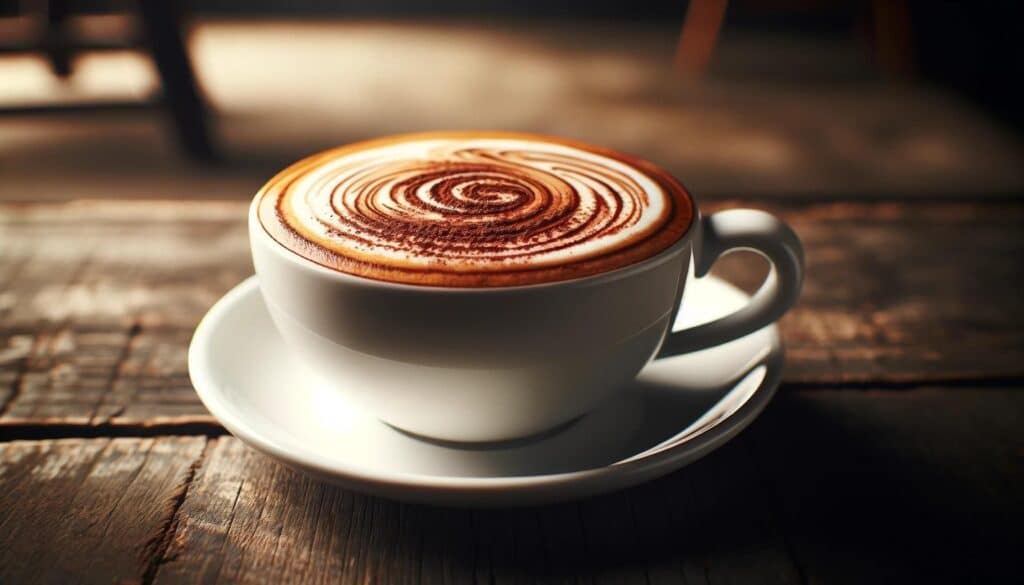
What is a Cappuccino?
A cappuccino is one of the most beloved and iconic coffee drinks worldwide, known for its perfect balance of espresso, steamed milk, and milk foam. Originating from Italy, the cappuccino has become a staple in coffee shops globally, appreciated for its robust flavor and creamy texture. Here’s an in-depth look at what makes a cappuccino unique and how it’s crafted.
Origin and Name
The term “cappuccino” is derived from the Capuchin friars, a branch of the Franciscan monks. The name refers to the distinctive color of the friars’ robes, which is similar to the color of the drink when mixed with milk. The cappuccino as we know it today developed in Italy and became popular in the mid-20th century, although variations of coffee with milk and foam have been enjoyed in Europe for centuries.
Components of a Cappuccino
A traditional cappuccino consists of three main components in equal parts:
- Espresso: The base of the cappuccino is a single shot of espresso, which is about 1 ounce. The espresso provides a strong, rich coffee flavor that is the foundation of the drink.
- Steamed Milk: The next layer is steamed milk, also about 1 ounce. The milk is heated and aerated to create a creamy texture that blends well with the espresso.
- Milk Foam: The top layer is milk foam, approximately 1 ounce, which is created by frothing milk until it becomes light and airy. This foam adds a velvety texture and insulates the drink, keeping it hot.
Preparation
Creating a perfect cappuccino requires skill and precision. Here are the steps typically followed by baristas:
- Pulling the Espresso Shot: A fresh shot of espresso is prepared using finely ground coffee beans and an espresso machine. The hot water is forced through the coffee grounds under high pressure, extracting a rich, concentrated coffee.
- Steaming the Milk: Whole milk is preferred for its ability to create a rich, creamy texture. The milk is steamed using the steam wand of the espresso machine, incorporating air to create microfoam. The goal is to achieve a velvety consistency without large bubbles.
- Layering the Drink: The steamed milk is poured over the espresso, followed by a layer of milk foam. The ideal cappuccino has a distinct separation between the espresso, steamed milk, and foam, creating a layered effect.
Variations
While the traditional cappuccino is known for its equal parts of espresso, steamed milk, and foam, there are several variations:
- Wet Cappuccino: Also known as a “light cappuccino,” this variation has more steamed milk and less foam, resulting in a creamier texture.
- Dry Cappuccino: This version contains more foam and less steamed milk, offering a stronger coffee flavor and a lighter texture.
- Flavored Cappuccino: Syrups or flavorings, such as vanilla, caramel, or chocolate, can be added to the cappuccino for a sweet twist.
Serving and Enjoyment
Cappuccinos are typically served in small cups, ranging from 5 to 6 ounces. The small serving size ensures that the drink is consumed quickly while still hot, preserving the flavors and textures of the espresso, milk, and foam.
Garnishes: Some cappuccinos are garnished with a sprinkle of cocoa powder, cinnamon, or chocolate shavings on top of the foam, adding an extra layer of flavor and visual appeal.
Consumption: In Italy, cappuccinos are traditionally enjoyed in the morning, often as part of breakfast. However, they are consumed throughout the day in other parts of the world, making them a versatile and popular choice.
Nutritional Information
The nutritional content of a cappuccino can vary depending on the type of milk used and any additional flavorings. On average, a classic cappuccino made with whole milk contains approximately:
- Calories: 80-100
- Protein: 4-5 grams
- Fat: 4-6 grams
- Carbohydrates: 6-8 grams
Using skim milk or alternative milk options like almond or soy milk can alter these values, often reducing the calorie and fat content.
Cultural Significance
Cappuccinos hold a special place in coffee culture, symbolizing both tradition and sophistication. In Italy, they are more than just a beverage; they represent a leisurely start to the day and a moment of enjoyment. The meticulous preparation and the balance of flavors make the cappuccino a drink that coffee enthusiasts around the world appreciate and savor.
Latte: Creamy and Versatile
A latte, or caffè latte, is a popular coffee drink known for its creamy texture and mild flavor. The term “latte” means “milk” in Italian, highlighting the drink’s main ingredient.

What is a Latte?
A latte, also known as a caffè latte, is a popular coffee beverage that stands out for its creamy texture and subtle flavor. Originating from Italy, the term “latte” translates to “milk” in Italian, highlighting the drink’s primary ingredient. This beverage is known for its versatility and wide appeal, making it a favorite among coffee enthusiasts around the globe. Here’s a detailed look at what makes a latte special and how it is crafted.
Origin and Name
The latte’s roots can be traced back to Italy, where it is commonly enjoyed as a breakfast drink. The term “caffè latte” means “coffee milk,” which perfectly describes the drink’s composition. In Europe, particularly in Italy, the latte has been a staple of coffee culture for many years, though it gained widespread popularity in other parts of the world more recently.
Components of a Latte
A latte is made up of three main components:
- Espresso: The foundation of a latte is a shot of espresso. This provides the robust coffee flavor that is the backbone of the drink.
- Steamed Milk: The majority of the drink is steamed milk, which gives the latte its creamy texture and mild flavor. The milk is heated and aerated to achieve a smooth, velvety consistency.
- Milk Foam: A small layer of milk foam is added on top for texture and presentation. This foam is typically light and airy, enhancing the drink’s visual appeal.
Preparation
Creating a perfect latte involves a few key steps, requiring both skill and precision:
- Pulling the Espresso Shot: A fresh shot of espresso is prepared using finely ground coffee beans and an espresso machine. The hot water is forced through the coffee grounds under high pressure, extracting a rich, concentrated coffee base.
- Steaming the Milk: Whole milk is often used for its ability to create a rich and creamy texture. The milk is steamed using the steam wand of the espresso machine, incorporating air to create microfoam. The goal is to achieve a smooth, velvety consistency without large bubbles.
- Combining the Components: The steamed milk is poured over the espresso, and a small amount of milk foam is added on top. The ideal latte has a smooth blend of espresso and milk, with a thin layer of foam on the surface.
Variations
Lattes are incredibly versatile, allowing for a wide range of variations to suit different tastes:
- Iced Latte: An iced latte is made by combining espresso with cold milk and ice, creating a refreshing beverage perfect for warm weather.
- Flavored Latte: Syrups or flavorings, such as vanilla, caramel, hazelnut, or mocha (chocolate), can be added to the latte for a sweet twist.
- Alternative Milks: Lattes can also be made with various milk alternatives, including almond milk, soy milk, oat milk, and coconut milk, catering to different dietary preferences and tastes.
Latte Art
One of the unique aspects of a latte is the potential for latte art. Skilled baristas often create intricate designs on the surface of the drink by manipulating the milk foam as they pour it into the espresso. Common designs include hearts, rosettas, and tulips. Latte art adds an aesthetic element to the coffee experience, making each cup visually appealing.
Serving and Enjoyment
Lattes are typically served in larger cups, ranging from 8 to 12 ounces or more. The higher milk content makes lattes creamier and less intense than other espresso-based drinks like cappuccinos or macchiatos.
Garnishes: Some lattes may be garnished with a sprinkle of cinnamon, cocoa powder, or chocolate shavings, adding an extra layer of flavor and visual appeal.
Consumption: Lattes are enjoyed throughout the day, often paired with breakfast, a snack, or as a comforting treat. Their creamy texture and mild flavor make them a versatile choice suitable for various occasions.
Nutritional Information
The nutritional content of a latte can vary depending on the type of milk used and any additional flavorings. On average, a classic latte made with whole milk contains approximately:
- Calories: 120-200
- Protein: 6-8 grams
- Fat: 6-10 grams
- Carbohydrates: 9-15 grams
Using skim milk or alternative milk options like almond or soy milk can alter these values, often reducing the calorie and fat content.
Cultural Significance
Lattes hold a significant place in coffee culture, symbolizing comfort and indulgence. They are often associated with leisurely mornings, relaxing afternoons, and cozy moments. The latte’s popularity has also led to the creation of many variations and specialties, such as the pumpkin spice latte, which has become a seasonal favorite.
Macchiato: Espresso with a Touch
The macchiato, meaning “stained” or “spotted” in Italian, is a coffee drink that highlights the boldness of espresso with a touch of milk.
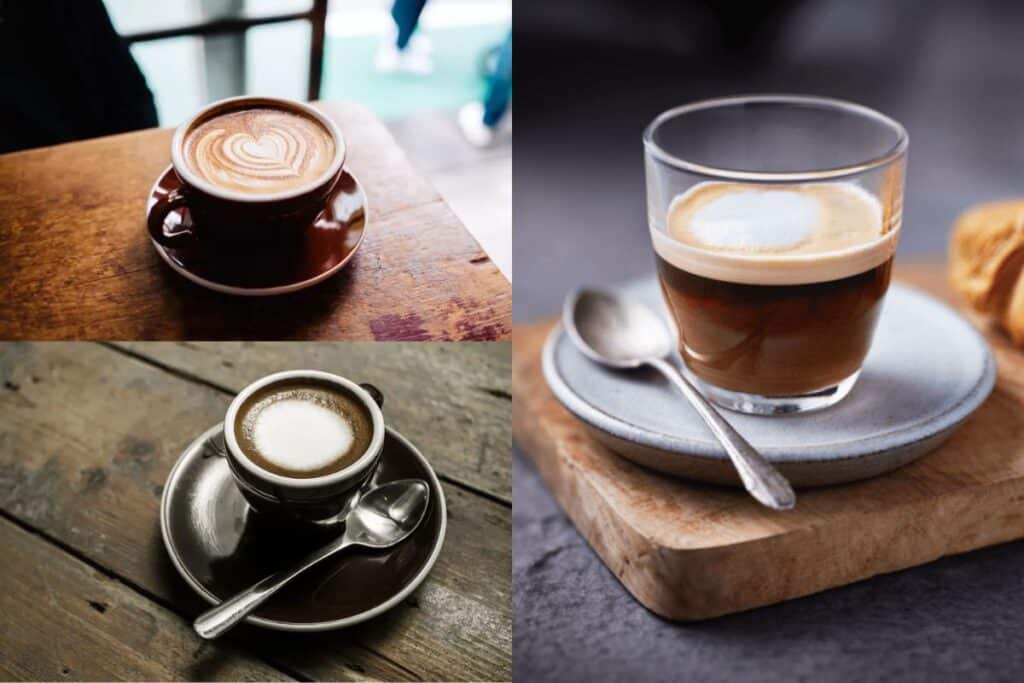
What is a Macchiato?
A macchiato is a popular espresso-based coffee drink that stands out for its strong flavor and simple preparation. The term “macchiato” means “stained” or “spotted” in Italian, referring to how the drink is “marked” with a small amount of milk or foam. This minimalistic approach highlights the boldness of the espresso while offering a hint of creaminess. Here’s an in-depth look at what makes a macchiato unique and how it is crafted.
Origin and Name
The macchiato originated in Italy, where it was created to distinguish a regular espresso from an espresso with a small amount of milk. Baristas would “mark” the espresso with a dollop of milk to indicate it was different from a standard shot. The name “macchiato” captures this essence, as it means “stained” or “spotted” in Italian, perfectly describing the appearance of the drink.
Components of a Macchiato
A macchiato consists of two main components:
- Espresso: The base of a macchiato is a shot of espresso. This provides the robust, concentrated coffee flavor that is central to the drink.
- Milk: A small amount of steamed milk or milk foam is added to the espresso. The milk can be steamed or frothed, depending on the desired texture.
Types of Macchiatos
There are two primary types of macchiatos: the espresso macchiato and the latte macchiato. Each offers a distinct coffee experience.
- Espresso Macchiato:
- Preparation: A single shot of espresso is “stained” with a small amount of steamed milk or foam. Typically, this involves adding just a teaspoon or two of milk.
- Flavor and Texture: The espresso macchiato retains the strong, bold flavor of espresso, with the milk adding a slight creaminess and mellowing the intensity. It is served in a small espresso cup, emphasizing the espresso’s prominence.
- Latte Macchiato:
- Preparation: The latte macchiato is the reverse of a traditional latte. Steamed milk is poured into a glass, and a shot of espresso is added on top, “staining” the milk. This creates a layered effect, with the espresso sitting atop the milk.
- Flavor and Texture: The latte macchiato has a milder flavor compared to the espresso macchiato, as the larger quantity of milk dilutes the espresso. The drink is creamier and typically served in a larger glass, showcasing the distinct layers.
Preparation
Creating a perfect macchiato involves a few key steps:
- Pulling the Espresso Shot: A fresh shot of espresso is prepared using finely ground coffee beans and an espresso machine. The hot water is forced through the coffee grounds under high pressure, extracting a rich, concentrated coffee.
- Steaming the Milk: Whole milk is often used for its ability to create a rich and creamy texture. The milk is steamed using the steam wand of the espresso machine, incorporating air to create microfoam. The amount of milk added depends on the type of macchiato being prepared.
- Combining the Components: For an espresso macchiato, a small amount of steamed milk or foam is added to the espresso. For a latte macchiato, steamed milk is poured into a glass, and the espresso is added on top.
Variations
Macchiatos can be customized in various ways to suit different tastes:
- Caramel Macchiato: Popularized by coffee chains, this version involves adding vanilla syrup to the steamed milk, then topping it with espresso and drizzling caramel sauce over the top. This creates a sweet and indulgent beverage.
- Iced Macchiato: An iced macchiato is made by pouring espresso over ice and adding a small amount of cold milk or foam. It offers a refreshing twist on the traditional macchiato.
- Flavored Macchiato: Syrups or flavorings, such as vanilla, hazelnut, or chocolate, can be added to the macchiato for a sweet twist.
Serving and Enjoyment
Macchiatos are typically served in small cups or glasses, highlighting the espresso’s bold flavor. The serving size for an espresso macchiato is usually around 2-3 ounces, while a latte macchiato can be served in a larger glass, around 8-12 ounces.
Garnishes: Some macchiatos may be garnished with a sprinkle of cocoa powder, cinnamon, or chocolate shavings, adding an extra layer of flavor and visual appeal.
Consumption: Macchiatos are enjoyed throughout the day, often as a quick pick-me-up or an afternoon treat. Their strong flavor and small serving size make them a versatile choice for various occasions.
Nutritional Information
The nutritional content of a macchiato can vary depending on the type of milk used and any additional flavorings. On average, a classic espresso macchiato made with whole milk contains approximately:
- Calories: 15-30
- Protein: 1-2 grams
- Fat: 1-2 grams
- Carbohydrates: 1-2 grams
Using skim milk or alternative milk options like almond or soy milk can alter these values, often reducing the calorie and fat content.
Cultural Significance
Macchiatos hold a special place in coffee culture, symbolizing simplicity and boldness. In Italy, they are often enjoyed as an afternoon or early evening drink, providing a quick burst of energy without the heaviness of a larger coffee beverage. The macchiato’s minimalist approach allows the espresso to shine, making it a favorite among coffee purists.
Key Differences
While cappuccinos, lattes, and macchiatos all contain espresso and milk, their differences lie in the proportions, preparation, and presentation.
- Milk Proportions:
- Cappuccino: Equal parts espresso, steamed milk, and foam.
- Latte: More steamed milk relative to the espresso, with a light foam topping.
- Macchiato: Primarily espresso with a small amount of milk or foam.
- Texture and Flavor:
- Cappuccino: Balanced, with a robust coffee flavor and a velvety texture from the foam.
- Latte: Creamier and milder, with the espresso flavor being more subdued.
- Macchiato: Strong espresso taste with a slight creaminess from the small amount of milk.
- Serving Size:
- Cappuccino: Smaller cup (6 ounces), which intensifies the flavors.
- Latte: Larger cup (8-12 ounces), offering a more diluted espresso experience.
- Macchiato: Typically served in a small espresso cup or glass, focusing on the espresso.
- Cultural Significance:
- Cappuccino: Traditionally enjoyed in the morning, particularly in Italy, where it is considered a breakfast drink.
- Latte: Common throughout the day and popular in many variations, often paired with breakfast or enjoyed as a relaxing beverage.
- Macchiato: Versatile in its consumption, suitable for those who enjoy a strong coffee flavor with a hint of milk any time of the day.
Choosing the Right Drink
Selecting the right coffee drink can greatly enhance your coffee experience, depending on your taste preferences, mood, and the occasion. Cappuccinos, lattes, and macchiatos each offer unique flavor profiles, textures, and presentations. Here’s a detailed guide to help you choose the perfect coffee beverage for any situation.
Understanding Your Preferences
- Flavor Intensity:
- Cappuccino: Offers a balanced flavor, with a strong coffee taste tempered by the creaminess of steamed milk and the lightness of foam. Ideal for those who enjoy a robust coffee experience without overwhelming milkiness.
- Latte: Provides a milder coffee flavor due to a higher milk content. Perfect for those who prefer a smoother, creamier drink that allows for various flavor additions.
- Macchiato: Highlights the boldness of espresso with just a hint of milk. Best suited for coffee purists who appreciate the intense flavor of espresso with a slight creaminess.
- Texture:
- Cappuccino: Known for its velvety texture, created by equal parts steamed milk and foam. The foam adds a light, airy mouthfeel, making it a delightful experience.
- Latte: Creamy and smooth, with a higher milk-to-espresso ratio. The steamed milk creates a rich texture, making it a comforting and indulgent choice.
- Macchiato: Offers a more straightforward texture, with the espresso’s intensity softened by a small amount of milk or foam. The texture varies depending on the type (espresso macchiato vs. latte macchiato).
- Serving Size:
- Cappuccino: Typically served in a 6-ounce cup, providing a concentrated coffee experience.
- Latte: Served in larger cups, ranging from 8 to 12 ounces or more, offering a more diluted coffee experience with a larger volume.
- Macchiato: Served in small espresso cups or glasses, emphasizing the espresso. Latte macchiatos can be served in larger glasses to showcase the layered effect.
Occasion-Based Choices
- Morning Routine:
- Cappuccino: A traditional choice for breakfast in Italy. Its balanced flavor and moderate caffeine content make it a great start to the day.
- Latte: Ideal for a leisurely morning. Its larger size and creamy texture make it a perfect accompaniment to breakfast or brunch.
- Macchiato: For a quick, intense caffeine boost, an espresso macchiato is a great option. If you prefer a lighter start, a latte macchiato can be a soothing alternative.
- Afternoon Pick-Me-Up:
- Cappuccino: Provides a satisfying and energizing boost without being too heavy. Perfect for a mid-afternoon break.
- Latte: A good choice if you’re looking for something comforting and relaxing. Flavored lattes can add a sweet treat to your afternoon.
- Macchiato: If you need a quick and strong caffeine hit, an espresso macchiato is ideal. A caramel macchiato can offer a sweet, energizing treat.
- Evening Relaxation:
- Cappuccino: While traditionally consumed in the morning, a cappuccino can be enjoyed in the evening if you prefer a balanced coffee drink.
- Latte: Decaf lattes can be a soothing, warm beverage to wind down your day. The creamy texture is perfect for relaxation.
- Macchiato: A decaf latte macchiato can be a light, evening-friendly option, offering the flavor without the caffeine kick.
Dietary Considerations
- Calorie and Fat Content:
- Cappuccino: Generally lower in calories and fat compared to lattes, especially if made with skim milk.
- Latte: Higher in calories and fat due to the larger milk content. Opt for skim milk or plant-based alternatives for a lighter option.
- Macchiato: The espresso macchiato is the lowest in calories and fat, as it contains minimal milk. A latte macchiato will have more calories but can be adjusted with milk choices.
- Milk Alternatives:
- Cappuccino: Works well with alternative milks like almond, soy, or oat milk. The foam may differ slightly depending on the milk type.
- Latte: Highly adaptable to various milk alternatives. Almond, soy, oat, and coconut milk are popular choices that can enhance the drink’s flavor and texture.
- Macchiato: Both espresso and latte macchiatos can be made with alternative milks. The choice of milk will slightly alter the flavor and texture but still provide a satisfying experience.
Personalization and Flavor Additions
- Flavor Syrups:
- Cappuccino: Can be enhanced with syrups like vanilla, caramel, or hazelnut. A sprinkle of cocoa powder or cinnamon on the foam adds extra flavor.
- Latte: Extremely versatile with flavor additions. Popular choices include vanilla, caramel, hazelnut, mocha, and seasonal flavors like pumpkin spice.
- Macchiato: Caramel macchiatos are a popular variation. Other flavors like vanilla or hazelnut can also be added to customize the drink.
- Sweeteners:
- Cappuccino: Typically enjoyed without added sweeteners, but a small amount of sugar or sweetener can be added to taste.
- Latte: Commonly enjoyed with sweeteners, especially in flavored variations. Sugar, honey, or artificial sweeteners can be used.
- Macchiato: An espresso macchiato is usually unsweetened, highlighting the espresso’s natural flavor. A latte macchiato can be sweetened according to preference.
Choosing the right coffee drink—whether it’s a cappuccino, latte, or macchiato—depends on your personal preferences, the occasion, and any dietary considerations. Each drink offers a unique experience, from the balanced and velvety cappuccino to the creamy and versatile latte, to the bold and minimalistic macchiato. Understanding the characteristics and variations of each can help you make an informed choice that enhances your coffee enjoyment. Whether you prefer a strong coffee flavor, a creamy texture, or a quick caffeine boost, there’s a perfect coffee drink for every moment and mood.
Conclusion
Cappuccinos, lattes, and macchiatos each offer unique coffee experiences, catering to different tastes and preferences. Whether you enjoy the balanced richness of a cappuccino, the creamy smoothness of a latte, or the bold simplicity of a macchiato, understanding these differences can help you appreciate the art and science behind each cup. Next time you’re at a coffee shop, you’ll be able to confidently choose the drink that best suits your mood and palate, enhancing your coffee journey.
By delving into the details of each drink’s preparation, flavor, and cultural significance, you can fully immerse yourself in the diverse world of coffee. Whether you are a seasoned coffee enthusiast or a casual drinker, knowing these nuances will elevate your coffee experience, allowing you to savor each sip with a deeper appreciation for the craft.
Frequently Asked Questions (FAQs) on Cappuccino, Latte, and Macchiato
1. What is the main difference between a cappuccino, a latte, and a macchiato?
The main difference lies in the proportions and preparation of espresso, steamed milk, and milk foam:
- Cappuccino: Equal parts espresso, steamed milk, and milk foam, creating a balanced and robust flavor.
- Latte: More steamed milk and less foam compared to a cappuccino, resulting in a creamier and milder coffee.
- Macchiato: Primarily espresso “stained” with a small amount of steamed milk or foam, highlighting the strong coffee flavor.
2. Which coffee drink has the most caffeine?
The caffeine content is generally similar across cappuccinos, lattes, and macchiatos since they typically start with a shot of espresso, which contains about 63 mg of caffeine. However, the total caffeine content can vary if additional shots of espresso are used, which is more common in larger lattes.
3. Can I customize these drinks with different types of milk?
Yes, you can customize cappuccinos, lattes, and macchiatos with various types of milk, including:
- Dairy Milk: Whole, skim, or 2% milk.
- Plant-Based Alternatives: Almond, soy, oat, coconut, and other milk alternatives. Each type of milk will slightly alter the flavor and texture of the drink.
4. Are there any calorie differences between these drinks?
Yes, the calorie content varies depending on the amount and type of milk used:
- Cappuccino: Typically has fewer calories due to equal parts of espresso, steamed milk, and foam (about 80-100 calories with whole milk).
- Latte: Contains more milk, leading to higher calorie content (about 120-200 calories with whole milk).
- Macchiato: The espresso macchiato is lowest in calories due to minimal milk (about 15-30 calories). Latte macchiatos have more calories but can be adjusted with milk choices.
5. What are the best times to enjoy each of these drinks?
- Cappuccino: Traditionally enjoyed in the morning, especially in Italy. Its balanced flavor makes it a great start to the day.
- Latte: Suitable for any time of the day. It pairs well with breakfast, brunch, or as a comforting afternoon treat.
- Macchiato: Ideal for a quick caffeine boost, typically consumed in the afternoon or early evening.
6. How do the textures of these drinks compare?
- Cappuccino: Velvety texture with a thick layer of milk foam, providing a light and airy mouthfeel.
- Latte: Creamy and smooth texture due to a higher milk-to-espresso ratio, creating a rich and indulgent experience.
- Macchiato: Depending on the type, it can have a straightforward texture with a slight creaminess (espresso macchiato) or a layered, creamy texture (latte macchiato).
7. Can these drinks be flavored?
Yes, all three drinks can be customized with flavor syrups and additions:
- Cappuccino: Commonly flavored with vanilla, caramel, or hazelnut syrups. A sprinkle of cocoa powder or cinnamon on the foam adds extra flavor.
- Latte: Highly versatile with flavor additions. Popular choices include vanilla, caramel, hazelnut, mocha, and seasonal flavors like pumpkin spice.
- Macchiato: Often flavored with caramel (caramel macchiato) or other syrups like vanilla or hazelnut.
8. What is the difference between an espresso macchiato and a latte macchiato?
- Espresso Macchiato: A shot of espresso “stained” with a small amount of steamed milk or foam. This drink emphasizes the strong espresso flavor with a hint of creaminess.
- Latte Macchiato: Steamed milk is “stained” with a shot of espresso, creating a layered drink with a milder flavor. It is essentially the reverse of a traditional latte.
9. Are these drinks available in iced versions?
Yes, all three drinks can be enjoyed cold:
- Iced Cappuccino: Espresso with cold milk and ice, topped with cold foam.
- Iced Latte: Espresso with cold milk and ice, often flavored with syrups.
- Iced Macchiato: Espresso poured over ice and cold milk, typically layered for a visual effect.
10. What are the serving sizes for these drinks?
- Cappuccino: Typically served in a small 6-ounce cup, concentrating the flavors.
- Latte: Served in larger cups, ranging from 8 to 12 ounces or more, providing a more diluted coffee experience with a larger volume.
- Macchiato: Served in small espresso cups or glasses for espresso macchiatos (about 2-3 ounces) and in larger glasses for latte macchiatos (about 8-12 ounces) to showcase the layers.

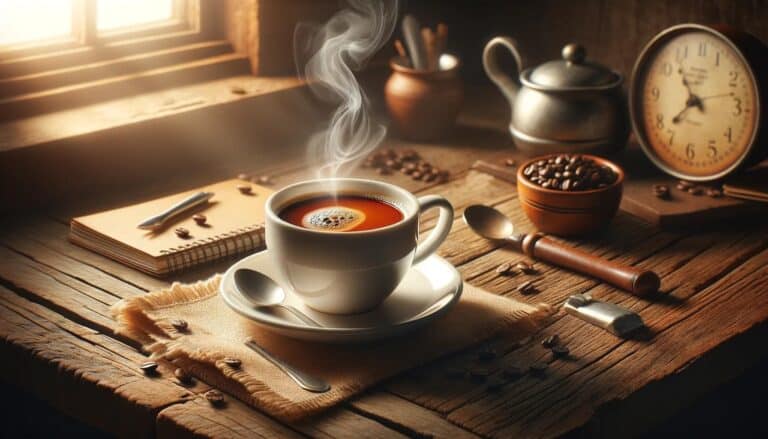
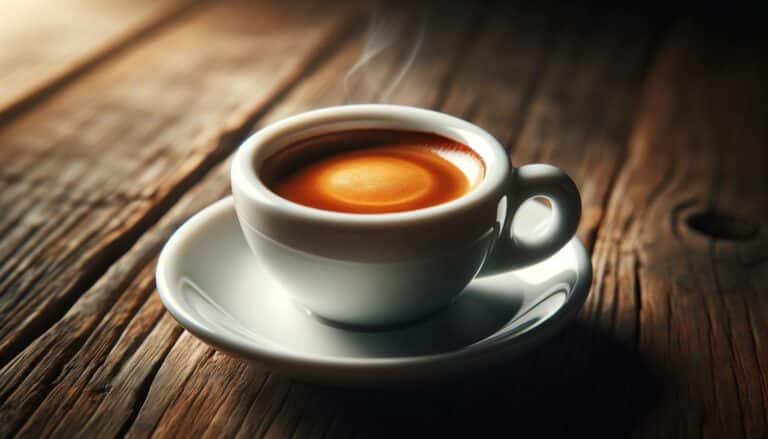


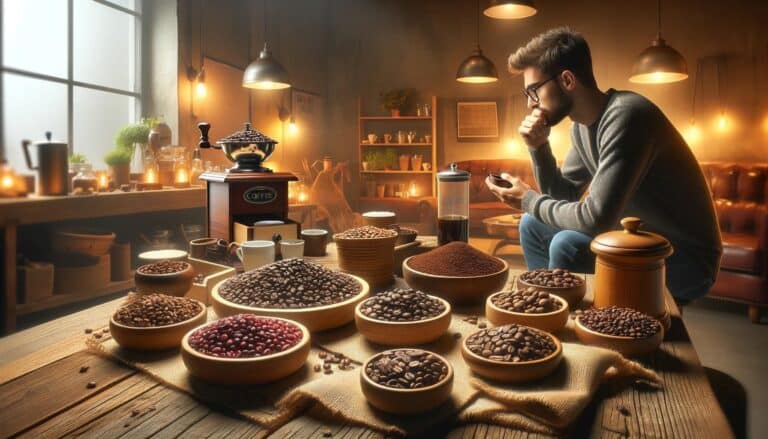

1 thought on “The Difference Between a Cappuccino, Latte, and Macchiato”
Very Informative